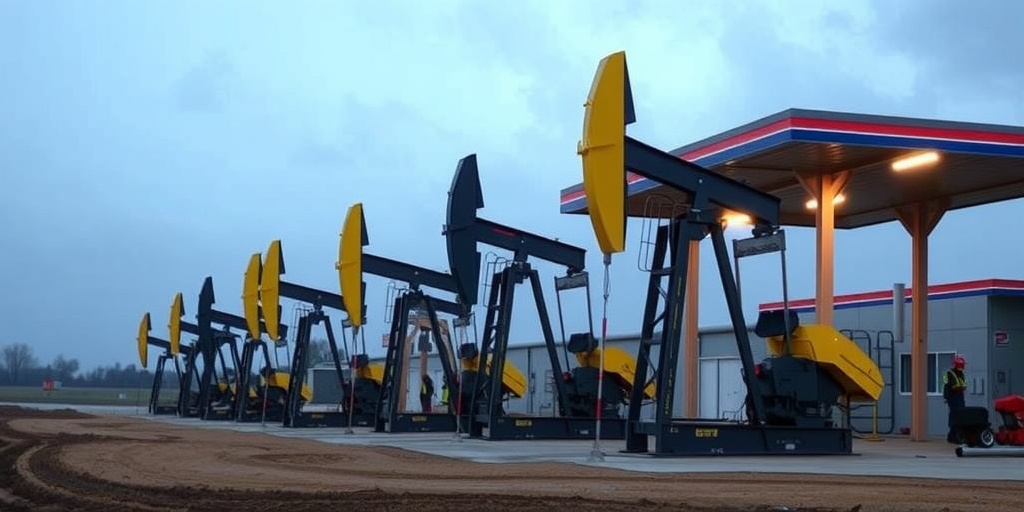Now Reading: Oil Prices Drop Amid Trump Tariffs and Economic Concerns
-
01
Oil Prices Drop Amid Trump Tariffs and Economic Concerns
Oil Prices Drop Amid Trump Tariffs and Economic Concerns

U.S. Oil Prices Plummet Amid Tariff Concerns: Economic Impacts and Future Outlook
U.S. oil prices experienced a significant drop over the weekend, with costs briefly dipping below $60 per barrel, marking the lowest levels seen in nearly four years. This sharp decline in oil prices can be directly attributed to the economic repercussions of President Trump’s latest tariff announcements, which have sent shockwaves through global markets.
As of Sunday, crude oil prices had fallen approximately 15 percent since the previous Wednesday, immediately following Trump’s revelation of aggressive new tariffs on imports from a wide array of countries. This steep price decrease has raised alarms among investors and analysts, who are increasingly worried that the imposed tariffs might impede economic growth in the United States and among its trading partners, possibly leading to recessions.
Historically, lower oil prices bring relief to consumers and businesses relying on fuels such as gasoline, diesel, and jet fuel. This sentiment aligns with the Trump administration’s ongoing efforts to push for reduced energy costs as a means to combat inflation. The administration has touted the benefits of lower prices for consumers, suggesting that reduced energy costs can stimulate spending in other areas of the economy.
However, the long-term implications of sustaining these lower prices or witnessing further declines raise serious concerns for U.S. oil and gas companies. If prices persist at their current levels, major operators are likely to slow drilling activities, reduce capital expenditures, and even consider workforce layoffs. Such actions would result in particularly harsh consequences for states heavily reliant on the oil and gas industry, such as Texas and New Mexico, where job losses could lead to broader economic challenges.
In addition to the domestic tariffs and their impacts, another critical factor contributing to the weakening of oil prices is the response from the Organization of the Petroleum Exporting Countries (OPEC) and its allied nations. Recently, OPEC members announced plans to accelerate production increases in response to declining prices. This move is likely to further inundate the market with oil, coinciding with analysts’ predictions of a potential dip in demand as economies grapple with the implications of higher tariffs.
U.S. energy companies, particularly smaller firms which are integral to the industry, are facing additional financial pressures. These companies are not only subject to the fallout from falling oil prices, but they are also grappling with rising costs associated with essential materials such as steel tubing. The 25 percent tariff on steel products, imposed by President Trump earlier in the year, has exacerbated the situation for energy producers, further squeezing profit margins.
The struggle has already begun to manifest in the stock market. Following Trump’s recent tariff announcement, the share prices of an exchange-traded fund, which is comprised of U.S. oil and gas stocks, plummeted by 20 percent within just two days, illustrating the immediate impact of tariff news on investor sentiment.
Looking forward, the outlook for the U.S. oil market remains precarious. Analysts are divided on how long prices will remain low and what future demand will look like amidst ongoing tariff tensions. Smaller oil companies, which generally operate with less financial flexibility, are expected to volunteer for cutbacks and adjustments sooner than their larger counterparts. This could lead to a significant restructuring within the industry as firms prioritize survival over expansion in an uncertain economic environment.
Overall, the recent fluctuations in oil prices underscore a broader narrative concerning the interplay between U.S. trade policies and the energy sector. With consumers initially benefitting from lower prices, the potential fallout for businesses and state economies highlights the complex repercussions of such policies. As the administration continues to navigate international trade relationships, the oil and gas sector will be critical in assessing both the stability of energy prices and the economic vitality of regions that depend on this vital industry. The coming months will be pivotal in determining the long-term effects of these developments, both for energy producers and consumers alike.
Stay Informed With the Latest & Most Important News
Previous Post
Next Post
-
 01New technology breakthrough has everyone talking right now
01New technology breakthrough has everyone talking right now -
 02Unbelievable life hack everyone needs to try today
02Unbelievable life hack everyone needs to try today -
 03Fascinating discovery found buried deep beneath the ocean
03Fascinating discovery found buried deep beneath the ocean -
 04Man invents genius device that solves everyday problems
04Man invents genius device that solves everyday problems -
 05Shocking discovery that changes what we know forever
05Shocking discovery that changes what we know forever -
 06Internet goes wild over celebrity’s unexpected fashion choice
06Internet goes wild over celebrity’s unexpected fashion choice -
 07Rare animal sighting stuns scientists and wildlife lovers
07Rare animal sighting stuns scientists and wildlife lovers





















